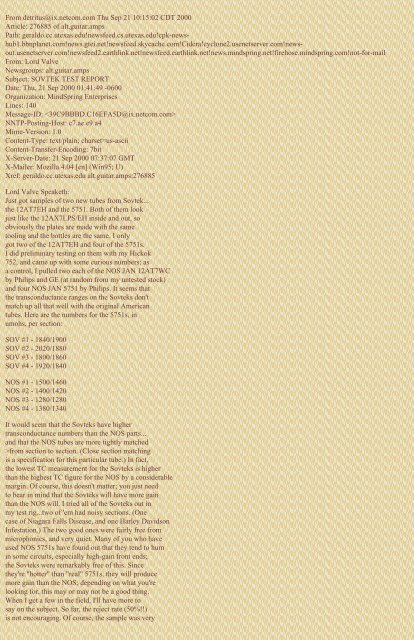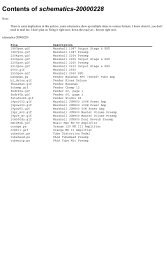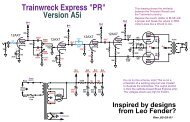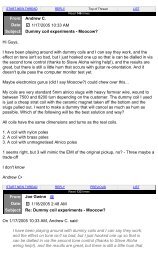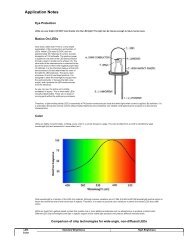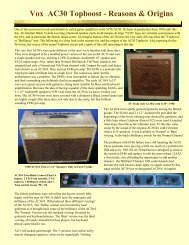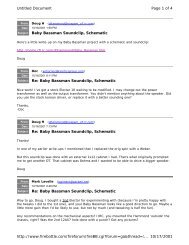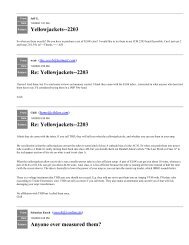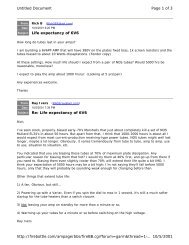Mic Kaczmarczik's TubeInformation - The Blue Guitar
Mic Kaczmarczik's TubeInformation - The Blue Guitar
Mic Kaczmarczik's TubeInformation - The Blue Guitar
Create successful ePaper yourself
Turn your PDF publications into a flip-book with our unique Google optimized e-Paper software.
From detritus@ix.netcom.com Thu Sep 21 10:15:02 CDT 2000<br />
Article: 276885 of alt.guitar.amps<br />
Path: geraldo.cc.utexas.edu!newsfeed.cs.utexas.edu!cpk-newshub1.bbnplanet.com!news.gtei.net!newsfeed.skycache.com!Cidera!cyclone2.usenetserver.com!newsout.usenetserver.com!newsfeed2.earthlink.net!newsfeed.earthlink.net!news.mindspring.net!firehose.mindspring.com!not-for-mail<br />
From: Lord Valve<br />
Newsgroups: alt.guitar.amps<br />
Subject: SOVTEK TEST REPORT<br />
Date: Thu, 21 Sep 2000 01:41:49 -0600<br />
Organization: MindSpring Enterprises<br />
Lines: 140<br />
Message-ID: <br />
NNTP-Posting-Host: c7.ae.e9.a4<br />
Mime-Version: 1.0<br />
Content-Type: text/plain; charset=us-ascii<br />
Content-Transfer-Encoding: 7bit<br />
X-Server-Date: 21 Sep 2000 07:37:07 GMT<br />
X-Mailer: Mozilla 4.04 [en] (Win95; U)<br />
Xref: geraldo.cc.utexas.edu alt.guitar.amps:276885<br />
Lord Valve Speaketh:<br />
Just got samples of two new tubes from Sovtek...<br />
the 12AT7EH and the 5751. Both of them look<br />
just like the 12AX7LPS/EH inside and out, so<br />
obviously the plates are made with the same<br />
tooling and the bottles are the same. I only<br />
got two of the 12AT7EH and four of the 5751s.<br />
I did preliminary testing on them with my Hickok<br />
752, and came up with some curious numbers; as<br />
a control, I pulled two each of the NOS JAN 12AT7WC<br />
by Philips and GE (at random from my untested stock)<br />
and four NOS JAN 5751 by Philips. It seems that<br />
the transconductance ranges on the Sovteks don't<br />
match up all that well with the original American<br />
tubes. Here are the numbers for the 5751s, in<br />
umohs, per section:<br />
SOV #1 - 1840/1900<br />
SOV #2 - 2020/1880<br />
SOV #3 - 1800/1860<br />
SOV #4 - 1920/1840<br />
NOS #1 - 1500/1460<br />
NOS #2 - 1400/1420<br />
NOS #3 - 1280/1280<br />
NOS #4 - 1380/1340<br />
It would seem that the Sovteks have higher<br />
transconductance numbers than the NOS parts...<br />
and that the NOS tubes are more tightly matched<br />
>from section to section. (Close section matching<br />
is a specification for this particular tube.) In fact,<br />
the lowest TC measurement for the Sovteks is higher<br />
than the highest TC figure for the NOS by a considerable<br />
margin. Of course, this doesn't matter; you just need<br />
to bear in mind that the Sovteks will have more gain<br />
than the NOS will. I tried all of the Sovteks out in<br />
my test rig...two of 'em had noisy sections. (One<br />
case of Niagara Falls Disease, and one Harley Davidson<br />
Infestation.) <strong>The</strong> two good ones were fairly free from<br />
microphonics, and very quiet. Many of you who have<br />
used NOS 5751s have found out that they tend to hum<br />
in some circuits, especially high-gain front ends;<br />
the Sovteks were remarkably free of this. Since<br />
they're "hotter" than "real" 5751s, they will produce<br />
more gain than the NOS; depending on what you're<br />
looking for, this may or may not be a good thing.<br />
When I get a few in the field, I'll have more to<br />
say on the subject. So far, the reject rate (50%!!)<br />
is not encouraging. Of course, the sample was very


